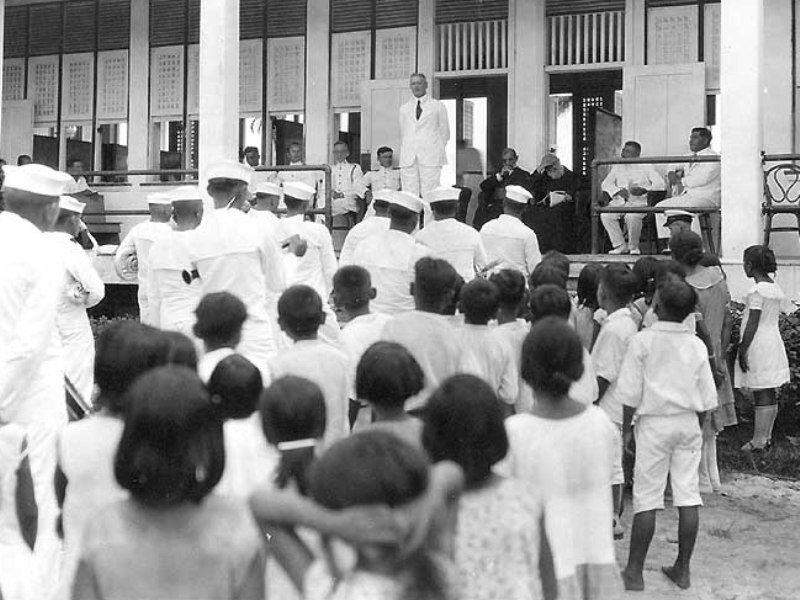
Marianas History: American Administration of Guam (1899-1941)

Figure 1.--The photo shows Willis W. Bradley Jr., Governor and Commander of Naval Station in Guam, speaking to Navy Band members, staff, and school personnel at Padre Palomo School, Guam, circa 1930. When the Japanese invaded the day after Pearl Harnor (December 8, 1941), therewasn't much more than the Navy band to resist them.
|
|
The United States obtaining Guam in the Spanish American war (1898-99). Siapan in the Treaty of Paris ceded Guam to the United
States. The United States paid $20 million for the island. The island population, The Guam Bellhas, totaled about 10,000
inhabitants, mostly Hispanized Chamorros. President William McKinley by executive order placed Guam under the administration of
the Department of Navy. The United States officially took possession of Guam (February 1899). The U.S. Naval Station, Guam, was
established (August 1899). The entire island was designated as Naval Station. The Commanding Officer, Captain R.P. Leary was
designated as the first American Governor of Guam. The Unites States was unsure just how to administer the native Chamorros /
Chamorus. The native Guamanians were given the status of U.S. nationals. They were not aliens, but neither were they U.S.
citizens. Guam under Spanish rule had languished. Under American administration, many improvements were initiated. These included
projects in agriculture, public health, sanitation, education, land management, taxes, and public works. One reform was
introducing a public system of nonsectarian education. Under the Spanish there was mission schools, but this was the first public
schools in the Marianas. Capt. Leary required each adult to learn to write his or her own name within -a specified time.
The American administration was humane, if somewhat intrusive. Capt. Leary required that couples cohabiting a home had to be
married. Relations with the Chamorros were not only correct, but generally friendly. The chamorros, including schoolchildren who
donated a penny each, collected $703.92 to have a ship's bell and commemorative plaque manufactured in Shanghai, China. The bell
was presented to the U.S. Navy and was used on each of the three USS Guam Naval vessels. The U.S. Navy used Guam as a refueling
and communication station. Pan Am operated a station and hotel on the island. It was part of the famed China Clipper route. The
United States in the Inter-War era while operating Guam as a naval station, did not fortify it. The Japanese in violation of
treaty obligations did fortify the Northern Marianas. As tensions mounted, Guam became an important listening post. Intercepts
were delivered to American code breakers. There were also intercept facilities in Hawaiian the Philippines (Cavite). The
British were also hard at work at Singapore and Australia. Guam was an intercept facility and communications center, but no
code breaking work went on there.
HBC

Navigate the Boys' Historical Clothing Web Site:
[Return to the Main German Empire page]
[Return to the Main Marianas history page]
[Return to the Main Marianas page]
[Return to the Main Oceania page]
[Introduction]
[Activities]
[Biographies]
[Chronology]
[Cloth and textiles]
[Clothing styles]
[Countries]
[Topics]
[Bibliographies]
[Contributions]
[FAQs]
[Glossaries]
[Images]
[Links]
[Registration]
[Tools]
[Boys' Clothing Home]
Created: 9:30 PM 1/2/2013
Spell checked: 3:11 AM 1/5/2013
Last updated: 3:11 AM 1/5/2013



